How air turbulence creates danger in the skies
Air travel and turbulence have always gone hand in hand with many flights, especially long haul, experiencing spells of bumpiness. The severe episode on board a Singapore Airlines plane in which one passenger died raises concerns about how risky turbulence can be.Experts say it is extremely unlikely that most flights will result in injury or damage, but there have been numerous recent incidents in which this has occurred.Understanding what causes turbulence can help air crew and passengers mitigate its impact.READ MORE: The best budget cities for travellers in Europe have been revealed"Turbulence fatalities on commercial flights are fortunately very rare, but have sadly increased by one today," Paul Williams, a professor of atmospheric science at the University of Reading in the UK, said in a statement released today.Here's how air turbulence can create problems for air travellers.What is turbulence and what causes it?There are four main levels of turbulence – light, moderate, severe and extreme.In cases of light and moderate turbulence, passengers might feel a strain against their seatbelt, and unsecure items in the cabin may move around.However, in more serious cases, turbulence can result in passengers being thrown around the cabin, leading to severe injuries, or death.READ MORE: The most in-demand cruise destinations for Aussies in 2024"Turbulence on flights can be caused by storms, mountains, and strong air currents called jet streams," adds Williams."In this last case, it is called clear-air turbulence, and it can be difficult to avoid because it doesn't show up on the weather radar in the flight deck.""Clear air turbulence is air movement created by atmospheric pressure, jet streams, air around mountains, cold or warm weather fronts or thunderstorms," according to the Federal Aviation Administration website.Pilots are sometimes warned of reports of turbulence by the Federal Aviation Administration, airline meteorology teams or even other pilots flying ahead of them in advance. However, turbulence can also occur without warning.How dangerous is it?According to the FAA, 30 passengers and 116 crew members were seriously injured due to turbulence from 2009 to 2021.Airline passenger numbers are currently estimated to be at around four billion a year, so such incidents are clearly still rare.The FAA cites turbulence as the leading cause of injuries to flight attendants and passengers in nonfatal accidents on commercial airlines.As airlines aren't required to report more minor injuries, the total number of injuries is unclear.Fatalities, such as the Singapore Airlines incident, are also extremely uncommon. A December 1997 United Airlines flight from Tokyo to Honolulu also experienced turbulence that left one person dead."Turbulence makes flights bumpy and can occasionally be dangerous," says University of Reading meteorology researcher Mark Prosser."Airlines will need to start thinking about how they will manage the increased turbulence, as it costs the industry $150–500m annually in the USA alone."Every additional minute spent travelling through turbulence increases wear-and-tear on the aircraft, as well as the risk of injuries to passengers and flight attendants."Is it getting worse?A study by the University of Reading reported that severe turbulence had increased by 55 per cent in the past four decades due to the impact of climate change.In 2022, Williams, who co-authored the study, told CNN that he believed that severe turbulence "could double or triple in the coming decades."He went on to attribute this to "clear air turbulence," a type of turbulence that strikes suddenly is very difficult to avoid.According to figures from the National Transportation Safety Board, the flight crew had no warning in about 28 per cent of turbulence-related accidents from 2009 to 2018.READ MORE: Best time to visit BaliWilliams' analysis predicted that clear-air turbulence would increase significantly across the world in the coming decades."Typically, on a transatlantic flight, you might expect 10 minutes of turbulence," he added."I think that in a few decades this may increase to 20 minutes or to half an hour. The seat belt sign will be switched on a lot more, unfortunately for passengers."Should I wear a seatbelt the entire flight unless I'm going to the bathroom?The short answer to this is "Yes." A 2021 report by the NTSB indicated that the majority of passengers who were injured in "turbulence-related" accidents were not wearing their seatbelt at the time.Since it's sometimes impossible to anticipate when an aircraft will encounter clear air turbulence, the only way to be 100% safe is to keep strapped in for the whole ride.Does it damage aircraft?In cases of extreme turbulence, "where the airplane is tossed violently about and is impossible to control" structural damage can be caused to an aircraft, according to the US National Weather Service.Recent incidents, including the one affecting the Singapore Airlines flight, have also resulted to substantial damage to the airplane cabin.Are some routes worse than others?Turbulence can occur almost anywhere and at any height, but some areas are known for being more susceptible.The Singapore Airlines flight from London to Singapore, appears to encountered severe turbulence over Myanmar after crossing Southeast Asia's Andaman Sea.After an analysis of around 150,000 different flight routes, turbulence prediction website Turbli found that the journey between Santiago, Chile and Viru Viru International airport in Bolivia to be the most bumpy, while the route between Almaty, Kazakhstan, and the capital of Kyrgyzstan, Bishkek, came in second on the list, which was released last year.Nashville, Tennessee to Raleigh/Durham in North Carolina was ranked as the North American route with the highest average turbulence.

















